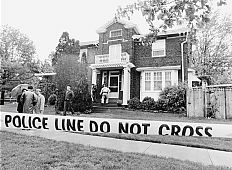 |
 |
 |
 |
News-Sentinel file photo
|
|
Lapp murder scene
Investigators gather evidence at the Rudisill Boulevard home of Sharon Lapp, a longtime critic of the administration of then-Mayor Win Moses and his police department. Lapp was found murdered on May 1, 1985, in an upstairs bedroom. |
|
|